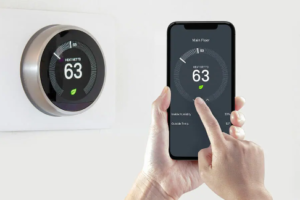How Smart Thermostats Are Revolutionizing HVAC Efficiency

Whether you’re interested in saving money on your energy bills or just looking to keep your home more comfortable, smart thermostats are the way to go. They’re revolutionizing HVAC efficiency by allowing homeowners to program a heating and cooling schedule tailored to their unique lifestyles. Some HVAC companies in San Antonio are increasingly recommending smart thermostats to their customers, as they are an easy and effective way to reduce energy consumption and improve indoor air quality.
Smart thermostats also help you track your energy usage. This knowledge can be used to make smarter, more energy-efficient choices that will save you money month after month.
Reduce Your Energy Bill
Thermostats can help you save energy by automatically adjusting your home’s temperature to meet your needs. They can also keep track of your energy usage and alert you if there are any problems with your heating and cooling system.
Smart thermostats learn and remember your habits, schedules, and preferences over time to adjust to your needs. This can save you money on your energy bill because it means your system won’t run when it’s not needed.
Many smart thermostats can be controlled remotely via an app on your smartphone or computer. Some even have voice control through Amazon Alexa, Google Assistant, or Apple Siri.
Thermostats also often offer geofencing and advanced learning technology. These features allow the thermostat to know when your home is occupied and when it’s not, and it can make adjustments accordingly. This can help you save money by reducing your energy consumption when you are away from home.
Increase Your Home’s Comfort
Smart thermostats can increase your home’s comfort and energy efficiency. These devices use advanced learning to adjust your temperature based on your habits and preferences.
For example, you might want to lower the temperature when you leave for work and raise it before you come home. This saves you energy and money without sacrificing the comfort of your home.
With some smart thermostats, you can even set a schedule to keep your home at the perfect temperature for the time of day.
Some also use geofencing technology to ensure your home is at the right temperature when you arrive. This feature can be a lifesaver when you leave your house in the morning and return late at night.
You can even get a monthly report on your energy usage and compare it to the averages of other households in your area. This helps you understand how your home uses energy and lets you plan for future improvements.
Save Money on Energy Bills
Smart thermostats are revolutionizing HVAC efficiency by using intelligent technology to adjust your settings based on your schedule and behavior. They’re also able to provide energy usage data that you can track, helping you make educated decisions about how to use less energy and save money on your utility bill.
Thermostats that have earned the ENERGY STAR certification use engineering estimates and real-world performance data to prove their savings. Thermostats that meet these criteria are designed to be easy to use and cost-effective for consumers. ENERGY STAR-certified products help keep energy bills low while saving homeowners money on their monthly energy costs.
In addition to these benefits, some smart thermostats have advanced learning and geofencing features that detect when you’re home and away and automatically adjust your settings accordingly. This can help reduce your energy usage while keeping you comfortable.
Keep Track of Your Energy Usage
Smart thermostats are essential – they track how much energy you use and save. This data helps you stay on top of your energy consumption, so you can discover how to save even more.
Many of the best-known brands offer a way to get this data, including Google, Nest, and Ecobee. These devices learn how you set your temperatures and make adjustments based on your habits over time.
Some models also feature geofencing technology that can change your settings when you leave or return home, ensuring you don’t waste energy by heating an empty house.
If you live in a temperate climate, these devices can help you cut your energy costs by about 8 percent. These devices will save you even more in places with scorching summers or freezing winters.